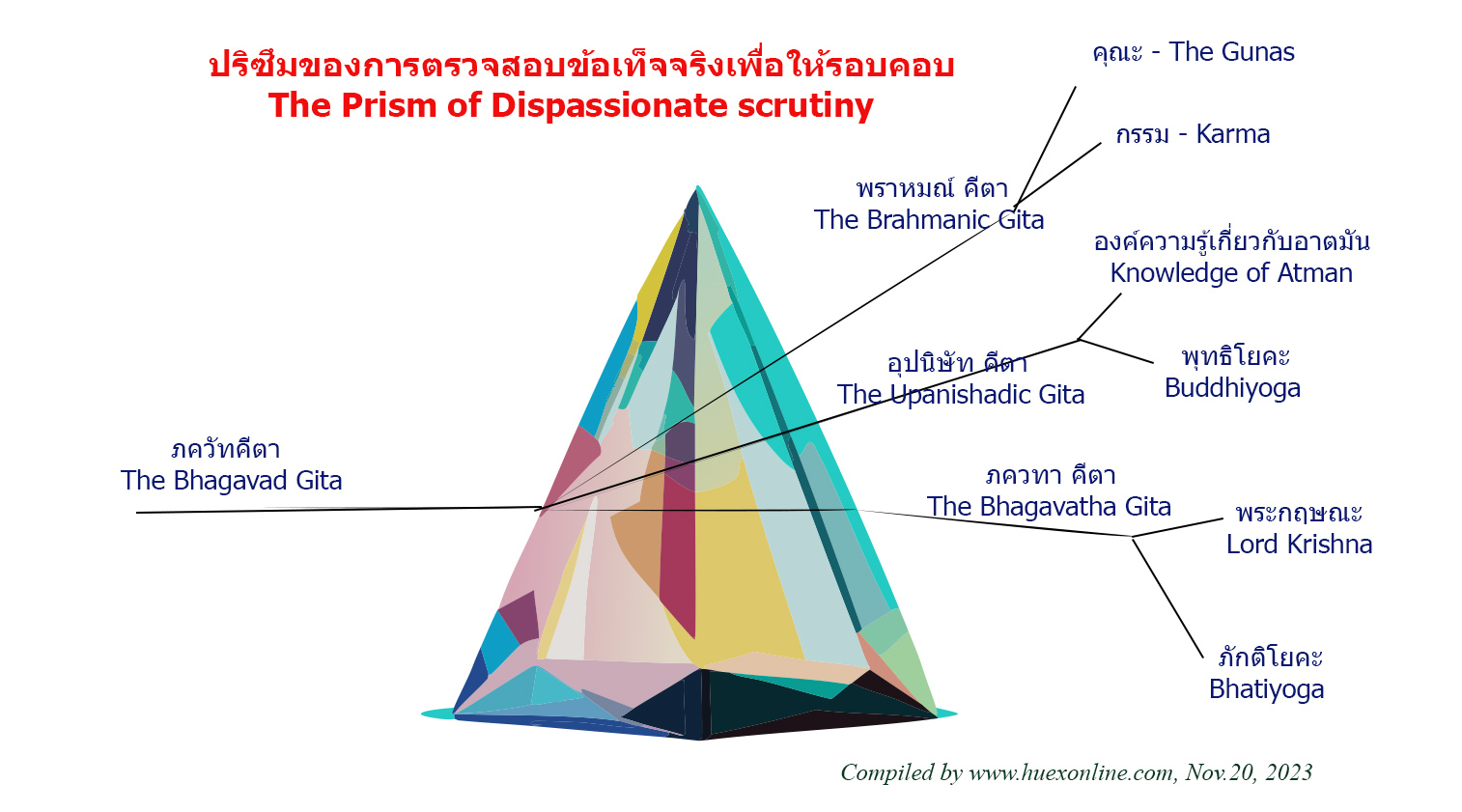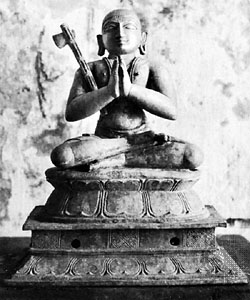3 The popular verse from the Vaiṣṇavīya Tantrasāra makes out that the Gītā restates the central teaching of the Upaniṣads. The Upaniṣads are the cows and the cowherd’s son, Kṛṣṇa, is the milker; Arjuna is the calf, the wise man is the drinker and the nectar-like gītā is the excellent milk.
sarvopaniṣado gāvo dogdhā gopālanandanaḥ
pārtho vatsaḥ sudhīr bhoktā dugdhaṁ gītāmṛtaṁ mahat.
14
…meditation. He draws all these living elements of Hindu life and thought into an organic unity. He adopts the method, not of denial but of penetration and shows how these different lines of thought converge towards the same end.
2. Date and text
The Bhagavadgītā is later than the great movement presented by the early Upaniṣads and earlier than the period of the development of the philosophic systems and their formulation in sutras. From its archaic constructions and internal references, we may infer that it is definitely a work of the pre-Christian era. Its date may be assigned to the fifth century B.C., though the text may have received many alterations in subsequent times.1
We do not know the name of the author of the Gītā. Almost all the books belonging to the early literature of India are anonymous. The authorship of the Gītā is attributed to Vyās, the legendary compiler of the Mahābhārata. The eighteen chapters of the Gītā from Chapters XXIII to XL of the Bhīṣmaparvan of the Mahābhārata.
It is argued that the teacher, Kṛṣṇa, could not have recited the seven hundred verses to Arjuna on the battlefield. He must have said a few pointed things which were later elaborated by the narrator into an extensive work. According to Garbe, the Bhagavadgītā was originally a Sāṁkhya-yoga treatise with which the Kṛṣṇa-Vāsudeva cult got mixed up and in the third century B.C. it became adjusted to the Vedic tradition by the identification of Kṛṣṇa with Viṣṇu. The original work arose about 200 B.C. and it was worked into its present form by some follower of the Vedānta in the second century A.D. Garbe’s theory is general rejected. Hopkins regards the work as “at present a Kṛṣṇaite version of an older Viṣṇuite poem and this in turn was at first an unsectarian work, perhaps a late Upaniṣad”2 Holtzmann…
---------------
1 I.P., Vol I, pp. 522-5.
2 Religions of India (1908), p. 389. Farquhar writes of it as “an old verse Upaniṣad, written rather later than the Śvetāśvatara, and worked up into the Gītā in the interests of Kṛṣṇaism by a poet after the Christian era.” Outline of the Religious Literature of India (1920). Sec. 95.
15
…looks upon the Gītā as a Visnuite remodelling of a pantheistic poem. Keith believes that it was originally an Upaniṣad of the Śvetāśvatara type but was layer adapted to the cult of Kṛṣṇa. Barnett thinks that different streams of tradition became confused in the mind of the author. Rudolf Otto affirms that the origin Gītā was “a splendid epic fragment and did not include any doctrinal literature.” It was Kṛṣṇa’s intention “not to proclaim any transcendent dogma of salvation but to render him (Arjuna) willing to undertake the special service of the Almighty will of the God who decides the fate of battles.”1 Otto believes that the doctrinal treatises are interpolated. In this he is in agreement with Jacobi who also holds that the original nucleus was elaborated by the scholiast into its present form.
These different opinions seem to arise from the fact that, in the Gītā, are united currents of philosophical and religious thought diffused along many and devious courses. Many apparently conflicting beliefs are worked into a simple unity to meet the needs of the time, in the true Hindu spirit, that over all of them broods the grace of God. The question whether the Gītā succeeds in reconciling the different tendencies of thought will have to be answered by each reader for himself after he completes the study of the book. The Indian tradition has always felt that the apparently incongruous elements were fused together in the mind of the author and that the brilliant synthesis he suggests and illuminates, though he does not argue and prove it in detail, fosters the true life of spirit.
For our purposes, we may adopt the text followed by Śaṁkara in his commentary as it is the oldest extant commentary on the poem.2
3. Chief Commentators
The Gītā has been recognized for centuries as an orthodox scripture of the Hindu religion possessing equal authority with the Upaniṣads and the Brahma Sūtra and the three…
---------------
1 The Original Gītā: E.T. (1930), pp. 12, 14.
2 The few variations of the text which we find in the Kashmir Rescension do not affect the general teaching of the Gītā. See F. A. Schrader: The Kashmir Rescension of the Bhagavadgītā (1930).
16
...together form the triple canon (prasthāna-traya). The teachers of the Vedānta are obliged to justify their special doctrines by an appeal to these three authorities and so wrote commentaries on them expounding how the texts teach their special points of view. The Upaniṣads contain many different suggestions about the nature of the Absolute and Its relation to the world. The Brahma Sūtra is so terse and obscure that it has been used to yield a variety of interpretations. The Gītā gives a more consistent view and the task of the commentators, who wish to interpret the texts to their own ends, becomes more difficult. After the decline of Buddhism in India, different sects arose, the chief being Advaita or non-dualism, Viśiṣtādvaita or qualified non-dualism, Dvaita or dualism and Śuddhādvaita or pure non-dualism. The various commentaries on the Gītā were written by the teachers in support of their own traditions (saṁpradāya) and in refutation of those of others. These writers are able to find in the Gītā their own systems of religious thought and metaphysics, since the author of the Gītā suggests that the one eternal truth which we are seeking, from which all other truth derives, cannot be shut up in a single formula. Again, we receive from the study and reflection of the scripture as much living truth and spiritual influence as we are capable of receiving.
The commentary of Śaṁkara (A.D. 788-820) is the most ancient of the existing ones. There were other commentaries older than his, to which he refers in his Introduction, but they have not come down to us.1
Śaṁkara affirms that Reality or Brahman is one without a second. The entire world of manifestation and multiplicity is not real in itself and seems to be real only for those who live in ignorance (avidyā). To be caught in it is the bondage in which we are all implicated. This lost condition cannot be removed by our efforts. Works are vain and bind us firmly to this unreal cosmic process (saṁsāra), the endless chain of cause and…
---------------
1 Ānandagiri in his comment on S.B.G., II, 10, says that the Vṛttikāra, who wrote a voluminous commentary on the Brahma Sūtra also wrote a Vṛtti or gloss on the Gītā urging that neither knowledge (jñāna) nor action (karma) by itself leads to spiritual freedom and a combined pursuit of them takes us to the goal.
Ramanujacharya or Ramanuja or Ilaiya Perumal, Source: www.britannica.com, Access date August 30, 2017.
17
…effect. Only the wisdom that the universal reality and the individual self are identical can bring us redemption. When this wisdom arises. The ego is dissolved, the wandering ceases and we have perfect joy and blessedness.
Brahman is definable only in terms of being. As It is above all predicates, especially all distinctions of subject, object and the act of cognition, It cannot be regarded as personal and there can be no love or reverence for It.
Śaṁkara holds that while action is essential as a means for the purification of the mind, when wisdom is attained action falls away. Wisdom and action are mutually opposed as light and darkness.1 He rejects the view of jñānakarmasamuccaya.2 He believes that Vedic rites are meant for those who are lost in ignorance and desire.3 The aspirants for salvation should renounce the performance of ritual works. The aim of the Gītā, according to Śaṁkara, is the complete suppression of the world of becoming4 in which all action occurs, though his own life is an illustration of activity carried on, after the attainment of wisdom.
Śaṁkara’s views are developed by Ānandagiri, who is probably as late as the thirteenth century, Śrīdhara (A.D.1400) and Madhusūdana (sixteenth century), among others. The Marāṭha saints, Tukārām and Jñāneśvar, are great devotees though they accept the position of Śaṁkara in metaphysics.
Rāmānuja (eleventh century A.D.), in his commentary, refutes the doctrine of the unreality of the world and the path of renunciation of action. He follows the interpretation given by Yāmunācārya in his Gītārthasaṁgraha. Brahman, the highest reality, is Spirit, but not without attributes. He has self-consciousness with knowledge of Himself and a conscious will to create the world and bestow salvation on…
---------------
1 IV, 37; IV, 33.
2 tasmād gītāsu kevalād eva tativajñānān mokṣaprāptih, na karma samuccitāt. S.B.G., II, 11. Even if karma may not be the immediate cause of liberation, still it is a necessary means for acquiring saving wisdom. Ś. Admits it: “Karmaniṣthayā jñānaniṣthāprāptihetutvena puruṣārthahetutvaṁ na svātantryeṇa.”
3 Avidyākāmavata eva sarvāṇi śrantādīni darśitāni.
4 Gītāśāstrasya prayojanaṁ paraṁ nihśreyasam, sahetukasya saṁsārasya atyantoparamalakṣaṇam. S.B.G., Introduction.
18
… His creatures. He is the sum of all ideal predicates, infinite and eternal, before and above all worlds, without any second. The Vedic gods are His servants created by Him and appointed in their places to perform their ordinated duties. The world is no deception or illusion but is genuine and real. The world and God are one as body and soul are one. They are a whole but at the same time unchangeably different. Before creation, the world is in a potential form, undeveloped into the existing and diversified manifestations. In creation, it is developed into name and form (nāmarūpa). By representing the world as the body of God, it is suggested that the world is not made from something alien, a second principle but is produced by the Supreme out of His own nature. God is both the instrumental and the material cause of the world. The analogy of soul and body is used to indicate the absolute dependence of the world on God even as the body is absolutely dependent on the soul. The world is not only the body of God but His remainder, īśvarasyaśeṣa, and this phrase suggests the complete dependence and contingency of the world.
All consciousness presupposes a subject and an object which is different from consciousness which is regarded by Rāmānuja as a dependent substance (dharmabhūtadravya), capable of streaming out. The ego (jīva) is not unreal and is not extinguished in the state of liberation. The Upaniṣad passage, tat tvam asi, “that art thou,” means that “God is my self” even as my soul is the self of my body. God is the supporting, controlling principle of the soul, even as the soul is the supporting principle of the body. God and soul are one, not because the two are identical but because God indwells and penetrates the soul, He is the inner guide, antaryāmin, who dwells deep within the soul and as such is the principle of its life. Immanence, however, is not identify. In time as well as in eternity, the creature remains distinct from the Creator.
Rāmānuja develops in his commentary on the Gītā a type of personal mysticism. In the secret places of the human soul, God dwells but He is unrecognized by it so long as the soul does not acquire the redeeming knowledge. We acquire this knowledge by serving God with our whole heart and…
19
…soul. Perfect trust is possible only for those who are elected by divine grace. Rāmānuja admits that the paths of knowledge, devotion and action are all mentioned in the Gītā, but he holds that its main emphasis is on devotion. The wretchedness of sin, the deep longing for the Divine, the intense feeling of trust and faith in God’s all-conquering love, the experience of being divinely elected are stressed by him.
The Supreme is Viṣṇu, for Rāmānuja. He is the only true god who will not share His divine honours with others. Liberation is service of and fellowship with God in Vaikuṇṭha or heaven.
Madhva (A.D. 1199 to 1276) wrote two works on the Bhagavadgītā, called the Gītābhāṣya and Gītātātparya. He attempts to drive from the Gītā tenets of dualistic (dvaita) philosophy. It is self-contradictory, he contends, to look upon the soul as identical with the Supreme in one sense and different from each other and any unity between them, partial or entire, is untenable. He interprets the passage “that art thou” as meaning that we must give up the distinction between mine and thine, and hold that everything is subject to the control of God.1 Madhva contends that devotion is the method emphasized in the Gītā.
Nimbārka (A.D. 1162) adopts the theory of dvaitādvaita (dual-non-dual doctrine). He wrote on Brahma Sūtra and his disciple Keśavakāṣmīrin wrote a commentary on the Gītā called Tattvaprakāśikā. Nimbārka holds that the soul (jīva), the world (jagat) and God are different from each other; yet the existence and activity of the soul and the world depend on the will of God. Devotion to the Supreme is the principal theme of Nimbārka’s writings.
Vallabha (A.D. 1479) develops what is called Śuddhādvaita or pure non-dualism. The ego (jīva) when pure and unblinded by illusions and the Supreme Brahman are one. Souls are particles of God like sparks of fire and they cannot acquire the knowledge necessary for obtaining release except by the grace of the Supreme. Devotion to God is the most important…
---------------
1 madīyaṁ tadīyam iti bhedam apahāya sarvam īśvarādhīnam iti sthitiḥ Bhāgavatatāiparya.
20
…means of obtaining release. Bhakti is truth associated with love.1
There have been several other commentators on the Gītā and in our own time, the chief are B. G. Tilak and Srī Aurobindo. Gandhi has his own views.
The differences of interpretation are generally held to be differences determined by the view-point adopted. The Hindu tradition believes that the different views are complementary. Even the systems of Indian philosophy are so many points of view or darsanas which are mutually complementary and not contradictory. The Bhagavadgītā says that the sages have described in various ways the essential truths.2 A popular verse declares: “From the view-point of the body, I am Thy servant, from the view-point of the ego, I am a portion of Thee ; from the view-point of the self I am Thyself. This is my conviction.”3 God is experienced as Thou or I according to the plane in which consciousness centres.
4. Ultimate Reality
The Gītā does not give any arguments in support of its metaphysical position. The reality of the Supreme is not a question to be solved by a dialectic which the vast majority of the human race will be unable to understand. Dialectic in itself and without reference to personal experience cannot give us with proofs of the existence of spirit.
The Upaniṣads affirm the reality of a Supreme Brahman, one without a second, without attributes or determinations, who is identical with the deepest self of man. Spiritual experience centres round a sovereign unity which overcomes the duality between the known and the knowing. The inability to conceptualize the experience leads to such descriptions as identity, pure and simple. Brahman, the subsistent simplicity, it its own object in an intuition which is its very…
---------------
1 premalakṣaṇā śraddhā. Amṛtataraṅgiṇī.
2 “iti nānāprasaṁkhyānāṁ tattvānāṁ kavibhiḥ kṛam.”
3 Dehabuddhyā tu dāso’haṁ jīvabuddhyā īvad aṁśakaḥ:
ātmabuddhyā tvam evāham iti me niścitā matiḥ.
See also Ānandagiri : Śaṁkaradigvijaya.
Sources, Vocabularies, & Narratives:
01. from. THE BHAGAVADGITA, S.RADHAKRISHNAN, HarperCollins Publishers India, 14th impression 2000, ISBN 81-7223-087-7.




